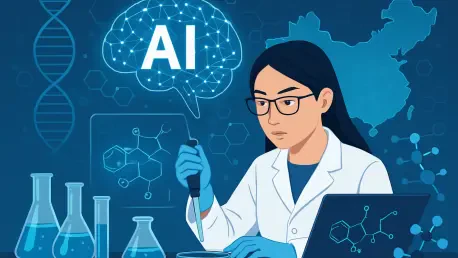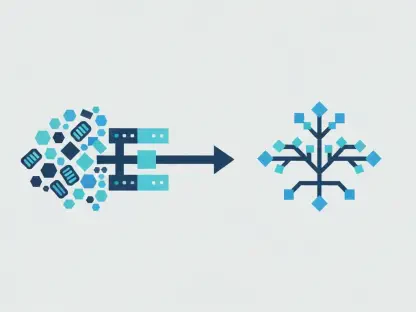In a world where the race to develop life-saving drugs is more competitive than ever, China has emerged as an unexpected frontrunner, leveraging artificial intelligence (AI) to transform the pharmaceutical industry and challenge long-standing global dynamics. Once primarily recognized for manufacturing low-cost generic medications, Chinese biotech companies are now pioneering innovative therapies, catching the eye of global pharmaceutical giants. This seismic shift is evidenced by historic, multibillion-dollar partnerships with industry leaders like AstraZeneca, Pfizer, and Sanofi, which highlight a growing trust in Chinese research capabilities. Beyond mere financial transactions, these collaborations signal a profound change in how the world views China’s role in drug discovery. This article explores the factors propelling China’s ascent in AI-driven biotech, from technological advancements to strategic alliances, and examines how this evolution is reshaping the global landscape of medical innovation. The journey from a traditional manufacturer to a hub of cutting-edge solutions is both remarkable and indicative of broader trends in technology and healthcare.
Harnessing AI for Revolutionary Drug Development
Chinese biotech firms are redefining drug discovery by integrating AI technologies to accelerate the creation of novel treatments. Companies like XtalPi and Insilico Medicine are at the forefront, utilizing sophisticated AI platforms to identify drug targets, screen potential candidates, and validate data with unprecedented speed. This approach is particularly impactful in addressing complex conditions such as cancer and autoimmune disorders, where traditional methods often take years. By automating and optimizing these processes, Chinese innovators are slashing both time and cost, offering a glimpse into a future where drug development could become far more efficient. The adoption of robotic labs further enhances this capability, allowing for high-throughput experimentation that outpaces conventional research models. This technological edge is not just a competitive advantage but a fundamental shift in how therapies are conceptualized and brought to market, positioning China as a key player in the next wave of pharmaceutical breakthroughs.
The impact of AI in China’s biotech sector extends beyond mere efficiency to the very nature of innovation itself. Unlike traditional drug discovery, which often relies on trial and error, AI-driven methods enable precise predictions about how compounds will interact with biological systems. This predictive power is transforming the way preclinical research is conducted, reducing the risk of costly failures in later stages. For instance, platforms developed by firms like CSPC Pharmaceutical Group are generating insights that attract global attention, as they promise faster pathways to viable treatments. Moreover, the ability to handle vast datasets allows these companies to uncover patterns and possibilities that might be missed by human researchers alone. As a result, China is not only keeping pace with global standards but, in many cases, setting new benchmarks for what is achievable in drug development, challenging long-held assumptions about where innovation originates in the pharmaceutical world.
Forging Historic Alliances with Global Pharma Leaders
A defining feature of China’s biotech boom is the scale and significance of its partnerships with Western pharmaceutical giants, which underscore a newfound confidence in Chinese innovation. AstraZeneca’s staggering $5 billion deal with CSPC for access to AI platforms and preclinical cancer drugs marks one of the largest agreements in this space, reflecting the high value placed on these technologies. Similarly, Pfizer has expanded its collaboration with XtalPi to leverage an AI-powered drug discovery platform, while Sanofi committed $1.7 billion to Helixon’s U.S. subsidiary, Earendil Labs, for antibody candidates. These deals are not mere financial transactions but strategic alignments that signal a shift in global R&D dynamics. Industry leaders, such as Pfizer’s CEO Albert Bourla, have openly commended the quality of research emerging from China, often following rigorous due diligence. This growing trust is redefining how international drugmakers approach collaboration, moving toward partnerships rooted in mutual innovation.
Beyond the headline figures, these alliances reveal a deeper integration of Chinese biotech into the global pharmaceutical ecosystem. Western companies, under pressure to replenish pipelines amid expiring patents, are finding in China not just cost-effective solutions but access to cutting-edge tools that enhance their own research capabilities. The willingness to co-develop and license AI-derived drug candidates speaks to a level of confidence that was rare a decade ago. For example, the agreements often include shared intellectual property and joint clinical trials, indicating a collaborative rather than transactional relationship. This trend suggests that China is no longer seen as a secondary player but as a vital partner in addressing some of the most pressing medical challenges. As these partnerships multiply, they are likely to accelerate the pace of drug discovery worldwide, while also elevating China’s standing as a hub for high-stakes innovation in healthcare.
Leveraging Unique Domestic Strengths
China’s rapid progress in AI-driven drug discovery is underpinned by a set of structural advantages that create a fertile ground for biotech growth. State-supported initiatives, including comprehensive national plans prioritizing AI and pharmaceutical innovation, provide a robust policy framework that encourages research and development. Local governments in key hubs like Shanghai are also channeling significant funding into the sector, fostering an environment where startups and established firms alike can thrive. Beyond policy, China’s enormous patient population, coupled with a national health insurance system covering over 600 million individuals, offers unparalleled datasets for training AI models. These datasets enable more accurate predictions and tailored treatments, giving Chinese companies a distinct edge in developing therapies that are both effective and scalable. This combination of governmental backing and data wealth is a cornerstone of China’s ability to compete on a global stage.
Another critical factor fueling China’s biotech ascent is its access to a vast and cost-effective talent pool, alongside entrepreneurial energy from academic circles. The country boasts a large number of skilled engineers and scientists specializing in AI and chemistry, whose expertise is often available at a fraction of the cost seen in Western markets. Additionally, many elite academics are launching their own startups, bringing cutting-edge research directly into commercial applications. This trend is amplified by investments from domestic tech giants like Tencent and Baidu, which are pouring resources into biotech ventures, blending technological prowess with medical innovation. The result is a dynamic ecosystem where ideas move swiftly from concept to reality, supported by both human capital and financial muscle. These domestic strengths not only sustain China’s current momentum but also position it to potentially redefine global standards in drug discovery over the coming years.
Navigating Global Competition and U.S. Challenges
As China advances in AI drug discovery, the U.S. biotech industry, long a global leader, faces mounting challenges that could impact its dominance. Despite leading in the number of biotech firms, AI research funding, and drug patent filings, the U.S. is grappling with potential revenue losses of up to $183.5 billion by 2030 due to expiring patents on blockbuster drugs. Proposed tax reforms and stricter visa policies for foreign researchers risk further hampering innovation by limiting access to global talent. These constraints come at a time when the cost of developing new drugs continues to rise, putting additional pressure on American firms to maintain their competitive edge. While the U.S. still invests heavily in venture capital for AI-driven drug discovery, with billions allocated annually, these looming issues could slow the pace of breakthroughs, creating an opportunity for other nations to gain ground in this critical sector.
In contrast, China is capitalizing on its momentum by attracting returning scientists and securing substantial investments from both state entities and private tech companies. This influx of talent and capital is enabling Chinese firms to rapidly scale their operations and refine their AI technologies, often unencumbered by the policy hurdles facing their American counterparts. The disparity in operating costs also plays a role, as licensing drugs or accessing platforms from Chinese companies often proves more economical for Western drugmakers than developing solutions in-house. Analysts note that while the U.S. retains a strong foundation for pioneering research, particularly in early-stage innovation, China’s ability to combine structural advantages with aggressive growth strategies is narrowing the gap. This evolving dynamic suggests that the global biotech landscape may soon reflect a more balanced distribution of influence, with China playing an increasingly prominent role.
Reflecting on a Transformative Shift
Looking back, China’s journey in AI-driven drug discovery marked a pivotal moment in the history of global healthcare innovation. What began as a shift from generic drug production to cutting-edge research evolved into a powerful force, driven by technological advancements and strategic partnerships with Western pharmaceutical leaders. Companies like CSPC, XtalPi, and Insilico Medicine demonstrated how AI could redefine the speed and precision of drug development, while multibillion-dollar deals with firms like AstraZeneca and Pfizer cemented China’s credibility on the world stage. The nation’s unique advantages, from vast datasets to state support, played a crucial role in this transformation, challenging traditional hierarchies in the biotech sector. As this era unfolded, it became evident that China had not only joined the ranks of innovators but had also reshaped the collaborative framework of global R&D. Moving forward, the focus should be on fostering sustainable partnerships and addressing ethical considerations in AI use, ensuring that this momentum translates into equitable access to life-saving treatments worldwide.









